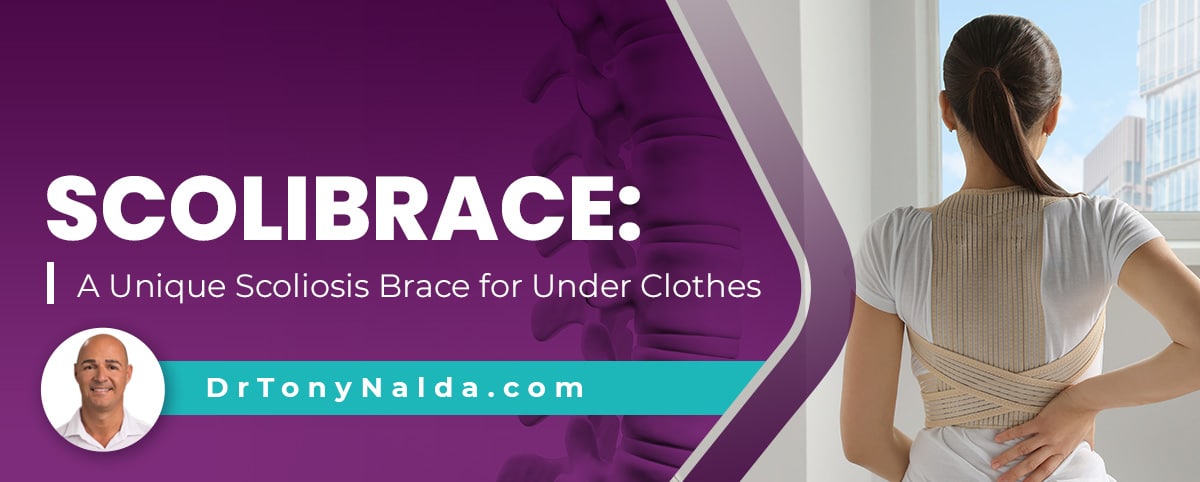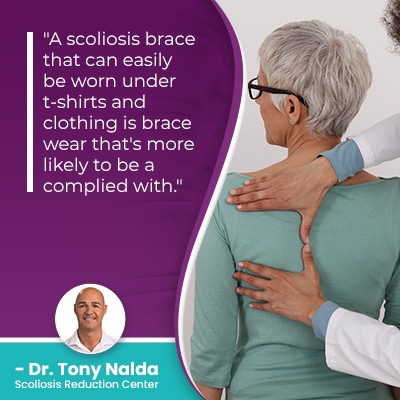Scolibrace: A Unique Scoliosis Brace for Under Clothes

Not all scoliosis braces are created equal. While some are designed around the goal of stopping progression, others are designed around the goal of correcting scoliosis. The former is more aligned with traditional scoliosis braces and treatment, while the latter is characteristic of modern conservative scoliosis treatment.
Just as there are different scoliosis treatment approaches, there are different types of scoliosis braces. The most commonly used brace in traditional treatment is the boston brace, and in modern conservative treatment, the ultra-corrective ScoliBrace is the brace of choice.
Although scoliosis affects all ages, it's most often diagnosed in adolescents between the ages of 10 and 18, as adolescent idiopathic scoliosis (AIS), so let's start by exploring the treatment challenges associated with AIS.
Table of Contents
Diagnosing Adolescent Idiopathic Scoliosis
Part of diagnosing scoliosis involves further classifying conditions based on key patient/condition variables, and this is done to streamline the treatment process and inform the crafting of customized treatment plans.
Scoliosis is classified based on patient age, curvature location, condition severity, and type.
Scoliosis involves the development of an unnatural sideways spinal curve that rotates, making it a complex 3-dimensional spinal condition, and a condition's severity is determined based on a measurement known as Cobb angle.
A patient's Cobb angle is determined during X-ray and involves drawing lines from the tops and bottoms of the curve's most-tilted vertebrae, at its apex, and the resulting angle is expressed in degrees.
The higher a patient's Cobb angle, the further out of alignment the spine is, the more noticeable the condition's effects are likely to be, and the more severe the condition:
- Mild scoliosis: Cobb angle measurement of between 10 and 25 degrees
- Moderate scoliosis: Cobb angle measurement of between 25 and 40 degrees
- Severe scoliosis: Cobb angle measurement of 40+ degrees
- Very-severe scoliosis: Cobb angle measurement of 80+ degrees
Condition severity is a key feature that treatment plans are based around, and as scoliosis is a progressive condition, it has it in its nature to get worse over time, so where a scoliosis is at the time of diagnosis isn't indicative of where it will stay.
Condition type is determined by causation, and the main type of scoliosis is idiopathic, meaning not clearly associated with a single known cause, and this accounts for approximately 80 percent of known diagnosed cases.
The remaining 20 percent are associated with known causes: neuromuscular scoliosis, degenerative scoliosis, and congenital scoliosis.
The most prevalent type of scoliosis overall is adolescent idiopathic scoliosis, diagnosed between the ages of 10 and 18, and this age group is the most at risk for rapid-phase progression because it's growth that triggers progression, and puberty involves unpredictable and rapid growth spurts.
Scoliosis bracing is known to be particularly effective on growing spines so is a regular facet of treatment for adolescent idiopathic scoliosis.
Scoliosis Bracing and Scoliosis Treatment
 When it comes to a diagnosis of scoliosis, the most important decision to be made is how to treat it moving forward, and this is because different scoliosis treatment approaches offer different potential results, delivered through different strategies, end goals, and brace preferences.
When it comes to a diagnosis of scoliosis, the most important decision to be made is how to treat it moving forward, and this is because different scoliosis treatment approaches offer different potential results, delivered through different strategies, end goals, and brace preferences.
There are two main scoliosis treatment approaches for patients to choose between: traditional and conservative.
Traditional scoliosis treatment offers a reactive response to a diagnosis of mild adolescent idiopathic scoliosis because it doesn't have a strategy for addressing scoliosis while mild, even though that's precisely when it's going to be the most responsive.
Modern conservative treatment responds to a diagnosis of mild adolescent idiopathic scoliosis very differently: with proactive treatment started as close to the time of diagnosis as possible.
Traditional Scoliosis Bracing
Traditional scoliosis treatment has the end goal of stopping progression, but this isn't the same as working towards actually correcting a scoliosis.
The most commonly used traditional scoliosis brace used is the boston brace, and this is limited in its potential efficacy for a couple of reasons; traditional bracing ignores the condition's rotational element so only treats it as a 2-dimensional condition, its design has changed little since its inception in the seventies, and the brace is bulky and uncomfortable to wear, causing compliance issues.
Measurements are taken, but the Boston brace is mass-produced so isn't fully customized to suit a patient's body and curvature type, making it less comfortable to wear, more noticeable, and this makes adolescents who simply want to fit in with their peers less likely to wear the brace as prescribed.
In order for any scoliosis brace to be effective, it has to be worn as prescribed, and when we're talking about the Boston brace, this can involve full-time wear from 18 - 23 hours a day for up to five years.
Compliance issues are a challenge when dealing with scoliosis bracing because traditional bracing can be bulky, noticeable, and uncomfortable to wear; the boston is also known to irritate skin, weaken the spine over time, and cause increased sweat.
Fortunately, there is a modern brace alternative that offers corrective potential, which is precisely what treating scoliosis conservatively involves.
Conservative Corrective Scoliosis Bracing
 When it comes to modern conservative treatment, corrective bracing represents the culmination of what we've learned about the condition over the years, and how it responds to treatment.
When it comes to modern conservative treatment, corrective bracing represents the culmination of what we've learned about the condition over the years, and how it responds to treatment.
Modern conservative treatment does have the goal of stopping progression, but this is one of the goals of treatment, and the main goal is achieving corrective results: impacting the condition on a structural level through a curvature reduction, increasing core strength so the spine's optimally supported by its surrounding muscles, and corrective bracing can help augment these results by pushing the spine into a corrective position.
Here at the Scoliosis Reduction Center, I opt for the ultra-corrective ScoliBrace because young scoliosis patients respond to it, wearing a brace that's customized is more likely to be worn as prescribed, it acknowledges the condition's true 3-dimensional nature, and is fully customized to suit a patient's body/curvature type, making it less bulky and easier to wear under clothes.
Issues like skin irritation and breathing problems associated with a more rigid and less customized brace like the Boston aren't present with the ScoliBrace; state-of-the-art schanning technology is applied to ensure that each brace is bespoke to its wearer.
A scoliosis back brace like the ScoliBrace can help improve an adolescent's self-confidence because while there are never treatment guarantees, when/if a young patient starts to see results, this can be highly motivating to continue treatment.
In addition, a corrective brace that pushes the spine into an aligned position, rather than squeezing it unnaturally, is known to help posture changes such as uneven shoulders, arms, and hips.
A scoliosis brace that can easily be worn under t-shirts and clothing is brace wear that's more likely to be a complied with.
I should be clear, however, that no brace on its own is enough to correct a scoliosis; when integrated into a proactive conservative treatment plan, corrective bracing can be a valuable facet of treatment, but as a structural spinal condition, it has to first and foremost be impacted on a structural level, and this is worked towards through condition-specific chiropractic care.
Conclusion
A brace that isn't customized to address a patient's body/curvature type is one that's going to have uncomfortable seams, heat control issues, be cumbersome to put on and remove, and is one that adolescents are not going to want to wear all day at school.
In terms of corrective potential, not wearing a brace that's prescribed for full-time wear full time will limit any potential efficacy, and in addition, traditional bracing that only addresses the condition as 2-dimensional, when it's rotational component makes it a complex dimensional condition, further limits any potential efficacy.
The modern corrective ScoliBrace addresses many of the shortcoming associated with traditional bracing by addressing its 3-dimensional nature, fully customizing each brace to suit a patient's body/curvature type so it's more comfortable and discreet to wear, and by pushing the spine into an aligned position, it can complement other treatment disciplines applied.
As kids grow, they are at risk for progression, so being proactive with treatment is important because as a progressive condition, scoliosis is incurable, but it can be highly treatable.
When the design of a brace based around a patient's body type and comfort, this is more likely to produce better rates of compliance. It doesn't matter how effective a brace can be; if it's not worn as prescribed, it won't be an effective facet of treatment.
Here at the Center, corrective bracing is just one facet of treatment that's combined with condition-specific chiropractic care, physical therapy to improve muscle strength, and rehabilitation to further heal and stabilize the spine.
When discussing treating scoliosis in teens, compliance is always a relevant issue; if a scoliosis brace causes sores, pain, has noticeable straps, and/or is uncomfortable and bulky to wear, a new brace with corrective potential could be the answer.
Dr. Tony Nalda
DOCTOR OF CHIROPRACTIC
After receiving an undergraduate degree in psychology and his Doctorate of Chiropractic from Life University, Dr. Nalda settled in Celebration, Florida and proceeded to build one of Central Florida’s most successful chiropractic clinics.
His experience with patients suffering from scoliosis, and the confusion and frustration they faced, led him to seek a specialty in scoliosis care. In 2006 he completed his Intensive Care Certification from CLEAR Institute, a leading scoliosis educational and certification center.
About Dr. Tony Nalda
 Ready to explore scoliosis treatment? Contact Us Now
Ready to explore scoliosis treatment? Contact Us Now





